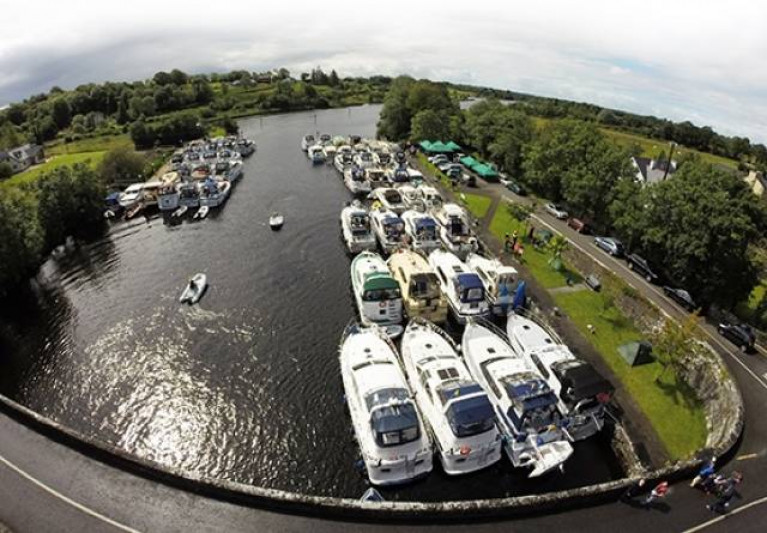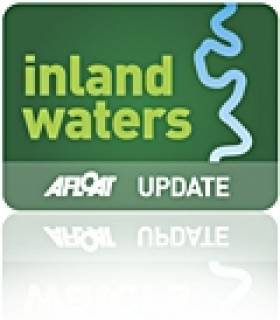Displaying items by tag: Shannon Boat Rally
Waterways Ireland advises masters of vessels on and users of the Shannon Navigation that the IWAI Shannon Boat Rally will be taking place from Saturday 29 July to Sunday 6 August at the following locations and dates:
- Saturday 29 & Sunday 30 July: Dromod
- Monday 31 July & Tuesday 1 August: Drumsna
- Wednesday 2, Thursday 3 & Friday 4 August: Lough Key Forest Park
- Saturday 5 & Sunday 6 August: Carrick-on-Shannon
Inland waterways users are advised to note that on the weekend of 5-6 August the fleet will be divided between Carrick Boat Club, Butler’s Marina and Emerald Star in the town.
This year’s Shannon Boat Rally is the latest inland waterways event to be postponed due to the coronavirus pandemic.
Hon Secretary Fiona Hoey made the announcement yesterday (Wednesday 6 May) in step with the guidelines of the National Public Health Emergency Team and HSE.
This would have been the 60th edition of one of the most prestigious and well-attended boating events on the inland waterways calendar.
“Whilst we greatly regret having to postpone the event, our primary concern is for the wellbeing of our boating community,” said Hey.
“The difficult decision reached will provide certainty to everyone involved and we look forward to having a great rally in 2021.”
The move comes days after the 49th Shannon Harbour Canal Boat Rally was also postponed, though there are hopes that event can be replaced with a gathering later in the year.
56th Shannon Boat Rally Visits Athlone
Organised jointly by the Athlone Branch and the Carrick Branch of the Inland Waterways Association of Ireland (IWAI), the Shannon Boat Rally (1961- 2016) is the most prestigious and well-attended boating event on Ireland’s inland waterways. “The families boating on the river love coming to Lough Ree and Athlone as part of the Shannon Boat Rally, said Commodore Keith Rowe, “We look forward to welcoming our boating friends both old and new to join us on Saturday 24th July for ten days and enjoy what the river Shannon has to offer. The Shannon is a wonderful resource being important to leisure and recreation, to heritage, to tourism and to the environment.”
“We know only too well how the river Shannon can bring flooding to our town but on this occasion we are celebrating a more positive side to our waterways. In Portrun this year we are launching a book by Donal Boland focusing on the secret and hidden beauty spots on the Shannon”, explained Mr Rowe. “We are also working closely with the RNLI”, he continued, “and this year we are focusing on taking a more proactive approach to boating safety.
“The main objective of the Shannon Boat Rally”, outlined the Commodore, Mr. Rowe “is to bring boaters of all types together to participate in a ten day long fun event for families and friends on the river. “ “The first rally, explained Mr Rowe, was launched at a civic reception in the Royal Hoey Hotel Athlone in 1961 with over 71 boats participating. Throughout its 56 year history over two-thousand nine hundred boats and over eleven thousand people have participated in the boat rally on the Shannon. This year we expect to attract just under 70 boats and three hundred people”, said Mr Rowe
“The Shannon, explained Mr. John Dolan the Association’s 18th President, from IWAI Offaly, “is a wonderful natural resource with a very significant positive impact for Athlone, and if managed can be a catalyst for urban and rural regeneration.”
The 56th Shannon Boat Rally is an annual event that attracts private boat owners and their families to the Shannon for their annual holidays, contributing to the local economy for the past 56 years. From its origins, the rally has grown in popularity every year attracting all classes of boats crewed by over three hundred adults, teenagers and children who participate in sports, games, sailing and boating competitions, quizzes, talent and music events while improving their boating skills and safety practices on our waterways. The rally brings boaters of all abilities and experiences together to share in a common purpose to enjoy the waterways, to share boating know-how and improve their boating skills. The boat rally has attracted many boaters to our inland waterways and promoted development of facilities along the navigation as well as bringing a great dynamic and valuable business to the towns and villages along the river and lakes. The boat rally also encourages responsible use of the waterways for the benefit of all waterway users and has a strong educational, environmental and boating safety theme.
At a recent meeting of the Carrick-on-Shannon Branch of the IWAI, Thomas Meegan from Drogheda Co. Louth was unanimously elected Commodore of the prestigious boat rally. The first Shannon Boat Rally was launched at a civic reception in the Royal Hoey Hotel Athlone in 1961 and with over 71 boats participated. That year the rally travelling from Athlone to Jamestown and on to Carrick on Shannon.

New Rally Commodore Thomas Meegan
Commodore Thomas Meegan explained that this year with over half a century of Inland Waterways boating tradition that we expect an entry of over 100 boats. Thomas outlined that throughout its 50-year history over 2,500 boats and 10,000 people have participated in the boat rally on the Shannon making a substantial economic contribution to the towns and villages along its annual itinerary route.
To mark its 25th year the Rally committee published in 1985 a book called "The Silver River" which documents in detail the early years of the boating event. The follow 25 years were documented with another books to mark the 50th anniversary called "Stories of a River" in 2010.
Thomas is no stranger to the Shannon water having started his boating carer some 23-years ago. His first boat was "Unique Lady" and having experienced a very rough sea trip to the Isle of Man, decided to try the more tranquil waters of the north Shannon. The Shannon won hands down over the rough salt waters off Clogherhead. Thomas with his wife Carmel and family are well know over the length of the river cruising on their boat "Misty Dawn". Thomas is a former Vice-Commodore of the Shannon Boat Rally and in 1998 too line honours when he won the prestigious Premier Award.
"The main objective of the Shannon Boat Rally", explained the Commodore, Thomas "is to bring all types of boaters together to participate in a ten day long fun event for families and friends on the river. "
From its origins in 1961, the rally has grown in popularity every year attracting up to 100 boats annually crewed by over 400 adults, teenagers and children who participate in sports, games, water and boating competitions, quizzes, talent and music events while improving their boating skills and safety practices on our waterways. The rally brings water users of all experiences together to share in a common purpose to enjoy the waterways, to share boating know-how and improve ones boating skills
The rally has attracted many boaters to our inland waterways and promoted development of facilities along the navigation as well as bringing a great dynamic and valuable business to the towns and villages along the river and lakes. The rally also encourages responsible use of the waterways for the benefit of all waterway users and has a strong educational and safety theme throughout.
2011 rally marks the 51st anniversary of the Shannon Boat Rally and it is a very special occasion in the annual IWAI boating calendar. The organising committee are planning a range of rally events and activities to suit all ages.
51st Rally Itinerary
The 51st rally begins on Friday 22nd July and runs until Sunday 31st July. Boats will travel from all locations to arrive in Carrick by Friday evening 22nd for an informal start of the activities.
The following morning, the rally will travel to Drumsna for the official opening.
Following a two night stay in Drumsna, the rally will then travel to Kilglass, Co. Roscommon, followed by Grange, Jamestown and finishing up in Carrick-on-Shannon with a Gala Dinner and prize giving in the Bush Hotel.
For details on the Shannon Boat Rally 2011 click here































































